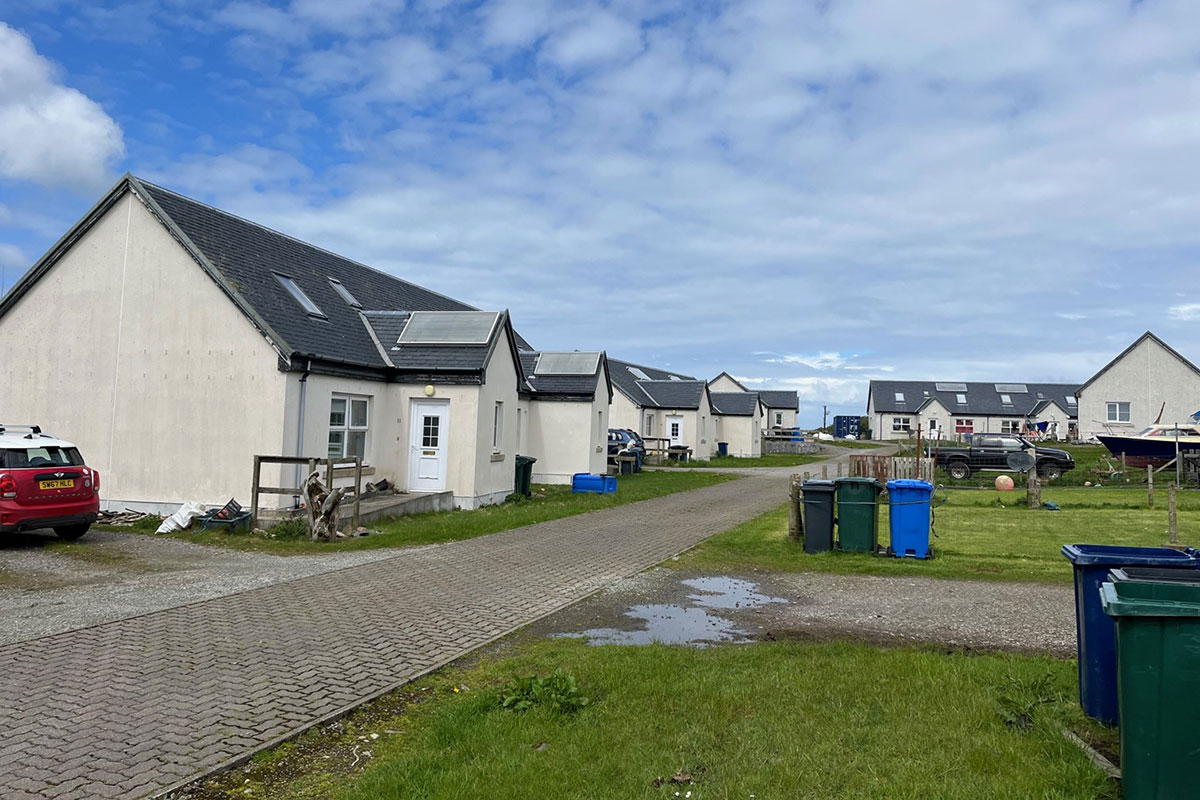You are viewing 1 of your 1 free articles
How to retrofit the remote Scottish islands
Facing extreme weather and unreliable ferries, collaboration between housing associations on these remote Scottish islands has made retrofit possible. Katharine Swindells reports. Photography by Martin Hunter
It feels more like a holiday than journalism as I sit on the ferry heading out from Western Scotland, taking in the sweeping waters and lush green coastline. We dock at a quaint seaside town, after 45 minutes on the ferry and an hour’s drive from Glasgow beforehand. But this is a short commute for those who provide housing out here. Picturesque though it may be, when it comes to building and maintaining homes, the remote, rural location brings a whole host of challenges.
Inside Housing is visiting the Scottish islands of Argyll and Bute, where 400 properties in need of eco upgrades are scattered in villages and towns across four islands.
Facing the prospect of complex logistics and high costs, housing associations in the Western Scottish islands have teamed up to deliver their retrofit projects as a joint venture, reducing complexity and costs in an economy of scale. But how was this partnership achieved and what can other associations learn?
Keith Langley was born and raised on Tiree, the most westerly island of the Inner Hebrides, with a population of 600 or so. Famed for its sweeping white-sand beaches, Tiree is a four-hour ferry crossing from Oban, which is a more than two-hour drive from Glasgow. Mr Langley and his wife Jaclyn moved back to Tiree in 2006 to raise their three children. The youngest still attends Tiree High School, which educates all of the island’s children from age three to 18.
“It’s different living here, there’s a nice pace of life,” Ms Langley says. “It’s a lovely, safe environment.”
The family are tenants of West Highland Housing Association (WHHA), and Mr Langley is the island’s only electrician. Ms Langley is the landlord’s customer relations officer, placing the couple at the heart of the island’s retrofit project.
Rural retrofit challenges
The remoteness that makes Tiree so peaceful also presents challenges. “We only have one co-op and a grocery shop; there’s no electrical merchant. You have to phone up, order something and they send it over by ferry,” Mr Langley explains.
When it comes to retrofit and major works, these logistical challenges can be enough to kill a project. The ferry only runs once a day and accommodation options are very limited in the tourist season, significantly increasing project costs and timescales.
“With our 14 properties on Tiree, we were struggling to work out how to fix them, and the only way we were able to do it was through partnership,” says Brett Sadler, chief executive of WHHA. “Not even just the costs but the practicalities – just finding a contractor who’d be willing to do it is a challenge,” he adds.
It would not have been financially viable for WHHA to retrofit just 14 homes under these conditions. So by working with Argyll Community Housing Association (ACHA) and Dunbritton Housing Association, it brought the cost and logistical difficulties down immensely.
“Because of our geography, we need to do things together,” explains Michelle Mundie, chief executive of ACHA. “You can’t do anything in isolation.”
David Chapman, group growth and development manager at Procast, the contractor leading on the project, says that the costs of retrofit works on the islands – including transporting and storing all the materials on the islands, as well as travel and accommodation for the workers – would usually be 20% higher than the same project on the mainland, with a full retrofit for one home coming in at around £100,000.
Even in the summer there can be major disruptions to the ferries, so Procast hired out two youth hostels for nine months for all the workers, set up an entire site compound and sent over all the materials for all the properties in the first month of works, to reduce the chance of delays down the line.
This approach means more homes can be retrofitted in a more strategic way and cuts costs. Mr Chapman estimates that this can bring the cost per home down by 30% to 40% compared with the previous scattered approach. And costs are still going down: Mr Chapman estimates that falling costs for materials across the market, combined with further economies of scale, means that in the next two years he could bring the cost per home down to half the original outlay. To date, the project value has been around £16m across the 400 properties.
He says: “The way they did it before had become this scatter-gun approach… Whereas if you have a long-term plan, you can let your tenants know that they are on the list and do it [in a] targeted [way], village by village.”
This approach means that works can be done on council and housing association properties in each area, as long as all providers buy in, and the same offer can be extended to private owners at the same at-scale cost, which improves the overall energy efficiency of a terrace of homes. “Another thing which used to infuriate tenants was doing it bit by bit – windows one year, then insulation another year – rather than now [when] we’re doing it all in one go,” Mr Chapman says.
Keys to a successful retrofit
Talking to the residents
Procast employed Jaclyn Langley, a tenant of West Highland Housing Association (WHHA), to be customer relations officer for the retrofit project on Tiree, so she could speak directly to her neighbours about the works.
The tenants all had to move into holiday homes for nine weeks and kept their belongings in shipping containers. “I was given the job of finding the best temporary housing for all the tenants, looking at what would suit their needs,” says Ms Langley. For tenants who do not drive, she tried to find them accommodation near the shop, or arranged taxi services for them. For older residents, Ms Langley arranged help for them to move their belongings out and back in.
“I also kept tenants updated on progress with the retrofit of their house, making sure they were back in so we could decant the next lot of tenants,” Ms Langley adds.
Procast’s David Chapman says from previous projects, the contractor had found much better resident buy-in when they had an example property with a full retrofit to show people in person. Across Argyll and Bute, Procast also uses word of mouth to its advantage.
“There’s much bigger buy-in because everybody’s nosy. So they’ll speak to their family and friends in another village and get feedback from them,” Mr Chapman explains.
“Doing this job, it really helps if you live in the community like I do,” Ms Langley says. “I know the other people whose homes were being retrofitted. I understand. I think everyone was a bit nervous. But once we were out of our houses and then got back to them, it was very positive!”
Becoming a part of the local economy
Finding the skills to carry out retrofit works on the islands is a major challenge. Procast had to bring many workers over due to the scale of the project, but also sees it as an opportunity to invest in the areas they are working in. This could be through local accommodation and food services, sub-contracting parts of the works to local companies, or upskilling workers through its training academy.
Early on during the Tiree project planning, Procast drafted in Keith Langley, a WHHA tenant and the only qualified electrician on the island, to work on the project and carry it on after the main works were done. He says: “I’ve lived here for so long [and] it’s a small island, so I know everyone very well. I also helped out after [the project], going round to each house, showing people how to use the new heating controls.”
Procast has trained Mr Langley in air source heat pumps, photovoltaic systems and battery storage systems so that he can carry out the repairs and maintenance of the retrofitted properties. This means people on Tiree do not have to wait for a repairs operative to travel over on the ferry. “It means you can give people the same repairs service they would get on the mainland. They’re not being discriminated against because they’re on the island,” Mr Chapman says.
This ongoing work means Mr Langley has been able to take on an apprentice employee – his nephew. “He was thinking about leaving the island but now he’s stayed, and with the retrofit, there’s even more work here,” he says.
Economies of scale do not just save time and money in terms of workers and materials, but also on the paperwork. The project used procurement frameworks from consultancy Procurement for Housing (PfH), which removed much of the time and labour required for individual tendering.
“Procurement is quite often seen as red tape, as more of hindrance than a help, but in reality it’s not,” states Chris McGinn, commercial manager at PfH Scotland. “The Scottish government encourages collaborative procurement, so if we get the likes of Michelle [Mundie] and Brett [Sadler] together and get their organisations collaborating, if it’s done right there’s real benefits. It allows you quick, efficient, compliant routes to market.”
And when working on a multi-organisation project across many locations like this, that efficiency is vital to ensure organisations can attract the right funding from government grants and private sector partnerships.
In Rothesay on the Isle of Bute, Inside Housing sidesteps construction workers to explore the site of 20 bedsits owned by ACHA, which are being turned into 20 one and two-bedroom homes. Completed to the PAS 2035 retrofit standard, the project received 50% funding – £2m – from the Scottish government’s Net Zero Fund. And since the workers and materials are all set up, Procast has been able to take on more projects at other properties in the local area.
Inside Housing walks past a pebbledash row where one home has guinea pigs in an enclosure outside. These homes are receiving a partial retrofit. Just down the street, another block of six two-bedroom flats are having indoor air source heat pumps installed with money from the government’s innovation fund.
Procast is also looking into getting National Lottery money to do up a shabby but beautiful art deco-style bar across the road.
But the system of funding is finicky. Organisations can spend months preparing the paperwork and even after that, the application might be rejected. Procast was lined up to retrofit a 36-home block in Rothesay and just a few days before meeting Inside Housing, it found out it would not receive funding from the Net Zero Fund. During our trip, Mr Chapman is in urgent conversations about getting another funding route approved so that the work can begin while the Rothesay site is still active. Otherwise the workers and materials will have moved on, and the opportunity will have been missed.
“It’s a minefield,” Mr Chapman says. “And it puts many companies off, which is a shame.”
The Argyll and Bute joint venture project is still ongoing, but already other housing associations are adopting the learnings. Mr Chapman says Procast has just signed a five-year partnership in Dumfries and Galloway, and another in Cumbria. It also has ambitions to collaborate in areas even as far away as Devon.
Meanwhile, on the Scottish Isles, Ms Mundie and Mr Sadler say this is only the beginning of their collaboration. ACHA now provides much of WHHA’s repairs service, and the organisations are exploring further joint procurement, perhaps in modern methods of construction development, and even sharing a graduate trainee scheme.
“In partnership working, this is only the start,” Mr Sadler says. “There’s loads of opportunities for us to take this further.”
Recent longform articles by Katharine Swindells
Top 50 Biggest Builders 2024
Which are the 50 housing associations building the most homes? What tenures are they building? And, with warnings already sounded about starts by the G15, what is happening to the pipeline? Katharine Swindells reports
Ready to check out: the lengthy repairs forcing tenants to live in hotels
Inside Housing has found tenants waiting months in temporary accommodation for repairs on their homes to be completed – or even started. Katharine Swindells reports
The estate where tenants are taking collective legal action on damp and mould
Tenants on one east London estate are teaming up to file a joint legal claim about the damp and mould in their homes. Katharine Swindells reports
The case for flooring to be included when social homes are let
Wales has just passed regulations that new social lets must come with flooring included. But with hundreds of thousands of families across the UK still living in social homes without carpet and flooring, should English and Scottish social landlords follow suit? Katharine Swindells reports
Sign up for our Scotland newsletter
Already have an account? Click here to manage your newsletters















